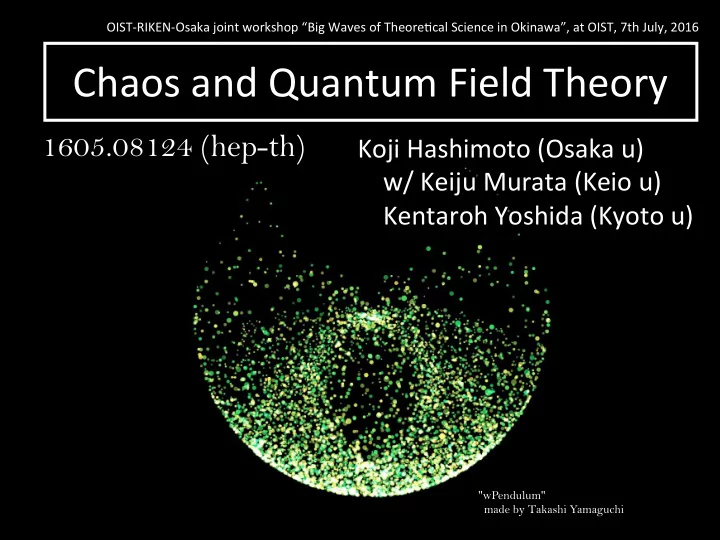

OIST-RIKEN-Osaka joint workshop “Big Waves of TheoreFcal Science in Okinawa”, at OIST, 7th July, 2016 Chaos and Quantum Field Theory 1605.08124 (hep-th) Koji Hashimoto (Osaka u) w/ Keiju Murata (Keio u) Kentaroh Yoshida (Kyoto u) "wPendulum" made by Takashi Yamaguchi
How is this quantum field theory chosen to be our universe? - 19 real parameters - Symmetry group : SU(3) x SU(2) x U(1) - Ma_er content : quark, lepton, Higgs, gauge bosons - Comlexity (Choas)? How?
� � L QCD = − 1 µ ν F aµ ν + ¯ 4 F a ψ i ( i γ µ D µ − m i ) ψ i Which “QCD” is more chao1c? 3
Which one is more chao1c? 4
Which one is more chao1c? 5
Chaos hidden in strongly coupled theories Chaos : sensiFve to iniFal condiFons 1 4 p Chaos in effecFve model of QCD 2 4p Chaos in exact (supersymmetric) QCD 3 5p 4 Discussion: chaoFc QFT 1p
1-1 Chaos : sensi1ve to ini1al condi1ons Classical chaos = Non-periodic bounded orbits sensiFve to iniFal condiFons in non-linear determinisFc dynamical systems Long history - Three-body planetary system [Poincare, 1892] - Atmospheric model, bu_erfly effect [Lorenz, 1963] - Billiard ball [Bunimovich, 1974] - Yang-Mills? [Savvidy 1981, Muller et al. 1992] Lots of applicaFons InformaFon theory : Kolmogorov-Sinai entropy ThermalizaFon of heavy ion collisions [Kunihiro et al., 2009] Math modeling in chemical reacFons, biology, economy, sociology, traffic forecast, financial crisis, cryptography, etc 7
1-2 Poincare sec1on captures chao1c phase x ( t ) ˙ Small Poincare energy secFon x ( t ) MoFon in the phase space Large energy 8
1-3 Lyapunov exponent is the chaos index d ( t ) ∼ d (0) exp[ Lt ] d ( t ) Lyapunov exponent d (0) 1 t log d ( t ) L = lim t →∞ lim d (0) d (0) → 0 L � 0 . 38 ( l 1 /l 2 = 1) L � 0 . 30 ( l 1 /l 2 = 2) 9
1-4 Chaos in quantum systems? Quantum chaos = QuanFzing classically chaoFc system Energy level spacings: Wigner, not Poisson Atomic energy spectra of Lithium [Pando-Zayas, 00] under a constant electric field 10
Chaos hidden in strongly coupled theories Chaos : sensiFve to iniFal condiFons 1 4 p Chaos in effecFve model of QCD 2 4 p Chaos in exact (supersymmetric) QCD 3 5p 4 Discussion: chaoFc QFT 1p
2-1 QCD is truly quantum ¯ Quarks are confined to form mesons ψ ψ ¯ ¯ ψγ 5 ψ ∼ π ψψ ∼ σ � ¯ ψ ( x ) ψ ( x ) � � = 0 Quarks are condensed, to break ψ ( x ) → exp[ i γ 5 θ ] ψ ( x ) chiral symmetry ψ ( x ) → ¯ ¯ ψ ( x ) exp[ i γ 5 θ ] spontaneously 12
2-2 Effec1ve model of QCD: Sigma model The model describes QCD with: - 1-flavor, ignoring anomaly - 2-flavor, neutral pion sector Breaking of U(1) (or sigma_3 of SU(2)) - spontaneously by chiral condensate Bo_om - explicitly by quark mass 13
2-3 Chaos of quark condensate Poincare secFons for E=100[MeV] E=130[MeV] E=140[MeV] E=150[MeV] E=160[MeV] E=200[MeV] 14
2-4 Posi1ve Lyapunov exponent 40 35 30 25 20 15 10 5 0 130 140 150 160 170 180 15
Chaos hidden in strongly coupled theories Chaos : sensiFve to iniFal condiFons 1 4 p Chaos in effecFve model of QCD 2 4 p Chaos in exact (supersymmetric) QCD 3 5p 4 Discussion: chaoFc QFT 1p
3-1 Exact classical meson theory of SQCD Classical acFon Meson masses: [Kruczenski, Mateos, Myers, Winters 03] EffecFve theory of mesons of “N=2 supersymmetric QCD” - N=4 Super Yang-Mills plus N=2 quark hypermulFplets - Parameter of the theory: - 2-flavor, quark mass - SU( ) gauge group with large - Large ‘t Hoos coupling 17
3-2 Deriva1on via string theory QCD, purely quantum Classical gravity (strong coupling limit) 2 D7-branes meson = N C D3-brane N=4 SU(N c ) Super Yang-Mills D7-branes in AdS 5 × S 5 + N=2 quark hypermultiplet [Maldacena, 98][Karch, Katz 02] 18
3-3 Equivalence to “Yang-Mills-Higgs” 19
3-4 Chaos of quark condensate Chaos-Order phase transiFon: Poincare secFons for E=0.05 E=0.1 E=0.3 E=0.6 E=0.8 E=1 20
3-5 Smaller Nc, more chao1c Lyapunov exponent Scale invariance 21
Chaos hidden in strongly coupled theories Chaos : sensiFve to iniFal condiFons 1 4 p Chaos in effecFve model of QCD 2 4 p Chaos in exact (supersymmetric) QCD 3 5p 4 Discussion: chaoFc QFT 1p
4 Discussion: chao1c QFT 1) Holographic principle? [Aref’eva, Medvedev, Rytchkov, Volovich 99] Integrability versus chaos. [Asano, Kawai, Yoshida, 15] Black holes? InformaFon loss? [Hawking 14] [Farahi, PandoZayas, 14] Upper bound of chaos? [Maldacena, Stanford, Susskind, 15] 2) Entropy producFon? Phase transiFon is a thermal entropy producFon. Kolmogorov-Sinai entropy = Shannon entropy rate [Latora, Branger, 99] ThermalizaFon from color glass? [Kunihiro, Muller, Ohnishi, Schafer, 10] 3) Standard Model? Cosmology? Higgs criFcality? Higgs inflaFon? Anarchy? 23
Chaos hidden in strongly coupled theories Chaos : sensiFve to iniFal condiFons 1 4 p Chaos in effecFve model of QCD 2 4 p Chaos in exact (supersymmetric) QCD 3 5p 4 Discussion: chaoFc QFT 1p
Recommend
More recommend